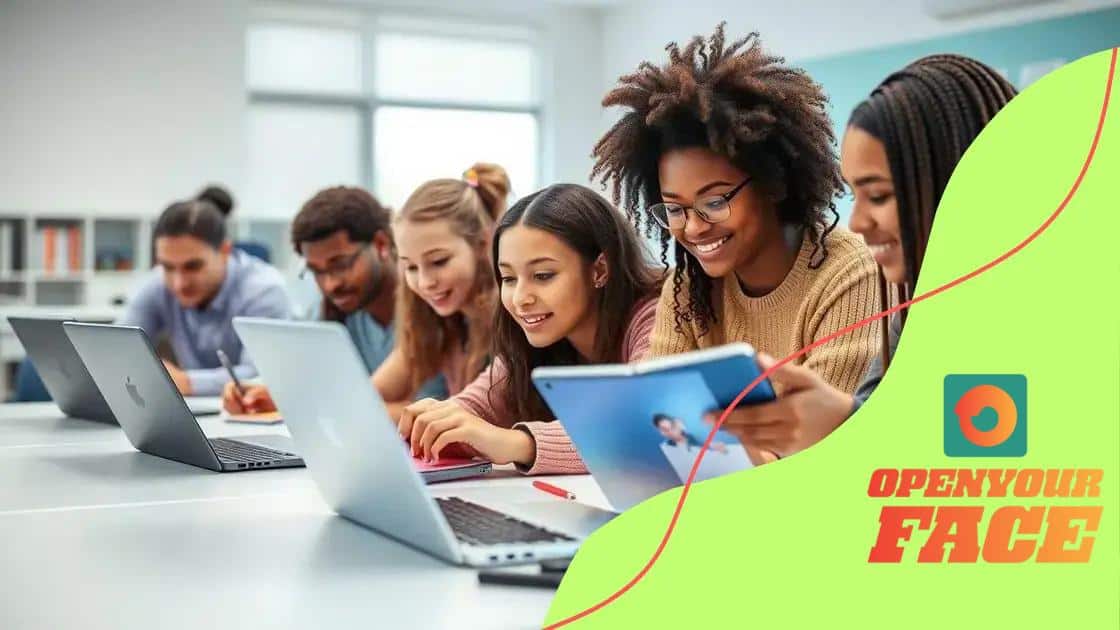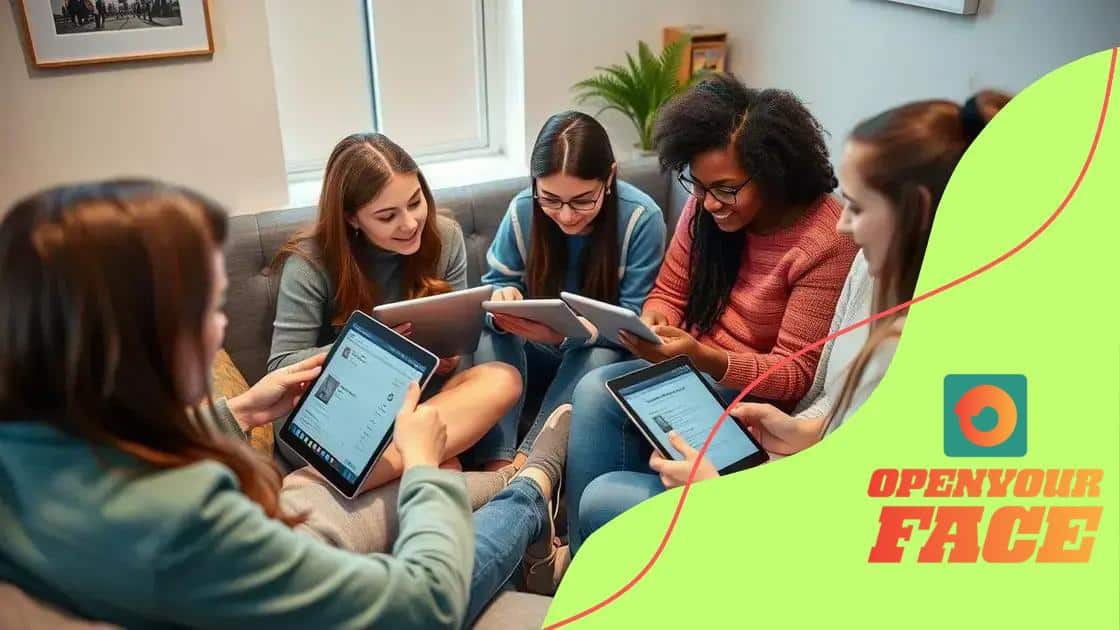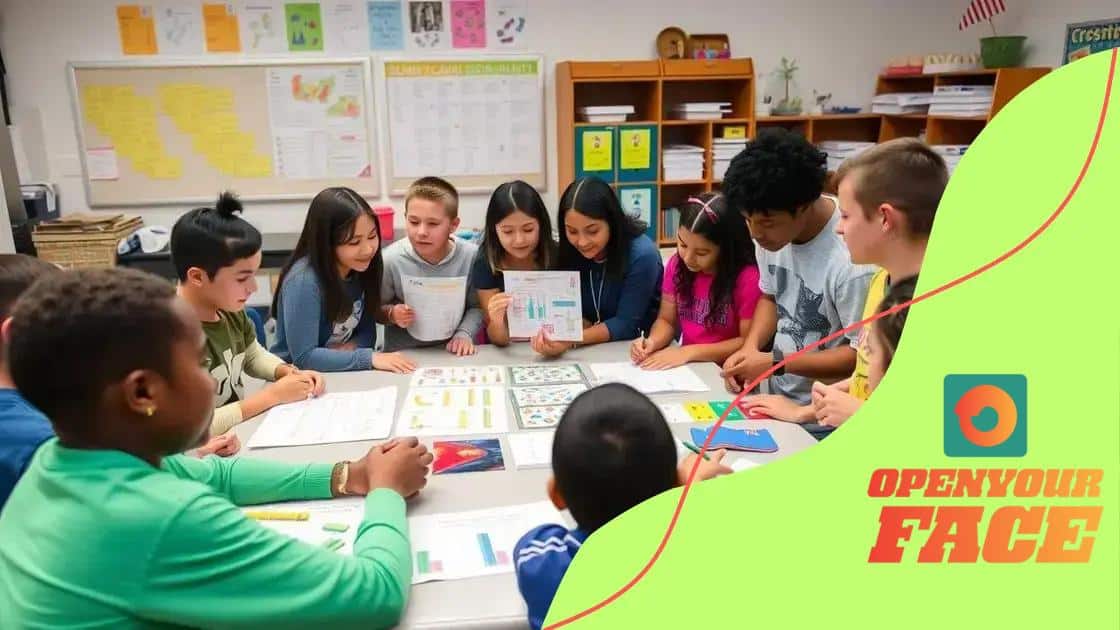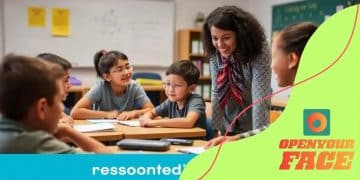How social media platforms are enhancing collaborative learning

Social media platforms enhance collaborative learning by increasing student engagement, facilitating global connections, and integrating advanced technologies, thereby transforming educational experiences.
How social media platforms are enhancing collaborative learning is an exciting topic worth exploring. These tools not only connect students but also foster creativity and teamwork. Have you ever wondered how these interactions shape the learning experience?
Benefits of social media in collaborative learning
Social media plays a crucial role in enhancing collaborative learning by providing platforms for students to engage and share ideas. With the right tools, students can connect with peers, fostering a learning environment that thrives on interaction and teamwork.
Increased Engagement
One of the primary benefits of social media is that it increases student engagement. When learners use familiar platforms, they feel more comfortable and willing to participate. This can lead to higher levels of motivation and investment in their education.
- Fosters open communication
- Encourages participation in discussions
- Allows for real-time feedback
- Supports sharing of ideas across different formats
Moreover, social media encourages collaboration beyond the classroom. Students can work together on projects, share resources, and learn from each other’s perspectives. This collective effort can enhance their understanding of subjects and build critical thinking skills.
Access to Diverse Resources
Social media provides access to a wide range of resources. Students can find articles, videos, and presentations that enhance their learning experience. This easy access to information can help students learn at their own pace and explore topics more deeply.
Additionally, engaging with peers and experts online allows students to develop important skills. They learn to communicate effectively, resolve conflicts, and work as part of a team. These skills are valuable not only in their academic life but in their future careers as well.
Ultimately, the benefits of social media in collaborative learning create an enriching experience for students, encouraging them to explore, innovate, and connect with others.
Engagement strategies using social media platforms

Using social media platforms effectively can significantly boost student engagement in collaborative learning. By implementing various strategies, educators can create a dynamic learning environment where students feel involved and motivated.
Interactive Discussions
Encouraging interactive discussions is key. Social media allows students to share their thoughts and opinions freely. This kind of interaction can help them feel more connected to the material and their peers.
- Use polls and surveys to gather input.
- Create discussion threads around assigned readings.
- Encourage students to comment on each other’s posts.
- Utilize video chats for real-time discussions.
These methods not only enrich learning but also develop critical skills like communication and teamwork. Students can learn from diverse viewpoints, resulting in a broader understanding of concepts.
Content Sharing and Collaboration
Another effective strategy is promoting content sharing. Social media platforms are perfect for students to share projects, articles, or resources. This not only enhances their learning experience but also fosters a sense of community.
Collaboration tools such as Google Docs and shared folders increase efficiency. When students work together on assignments using these tools, they can provide timely feedback and support each other.
Furthermore, incorporating multimedia elements like videos or infographics can capture attention and make learning more enjoyable. By using a variety of content formats, students are more likely to stay engaged and retain information.
Overall, using social media strategically can enhance engagement and create a vibrant, collaborative learning atmosphere.
Challenges and solutions in online collaboration
Online collaboration presents various challenges that can impact students’ learning experiences. Addressing these issues is crucial for maximizing the benefits of collaborative learning. Understanding these challenges can help educators design better learning environments.
Communication Barriers
Effective communication is vital in collaboration. Students may face difficulties in expressing their thoughts clearly online. This can lead to misunderstandings and frustration among group members.
- Encourage the use of clear language and concise messages.
- Implement guidelines for respectful communication.
- Use video calls to enhance personal connections.
- Provide feedback and support to improve communication skills.
By fostering good communication, educators can enhance collaborative efforts among students.
Technological Issues
Another common challenge is technical difficulties. Students may encounter problems with various tools or platforms, preventing smooth collaboration. This can interrupt the flow of teamwork and diminish productivity.
To combat these issues, ensuring that students have access to reliable technology is essential. Offering training sessions on the tools can also help students feel more confident in their abilities to use those resources effectively. By addressing technological challenges, learning experiences can remain engaging and efficient.
Ultimately, being aware of challenges and implementing effective solutions can enhance online collaboration. It creates a more fruitful learning environment that encourages teamwork and collective success.
Real-life examples of successful collaborative learning

Real-life examples of successful collaborative learning highlight the effectiveness of teamwork in educational settings. Many schools and organizations have embraced innovative approaches to teaching and learning, showcasing the power of collaboration.
The Virtual Classroom Project
This project connects students from different countries, allowing them to work on a common curriculum. By sharing their insights, students learn about diverse cultures while improving their collaborative skills. This interactive experience fosters understanding and builds lasting friendships across borders.
- Engages students with real-world issues.
- Encourages cultural exchange.
- Develops critical thinking and problem-solving skills.
The success of this project demonstrates how technology can bridge gaps between students worldwide.
Group Science Projects
In many classrooms, group science projects illustrate the benefits of working together. Students collaborate to design experiments and share their findings with the class. They learn various scientific concepts while developing essential teamwork skills.
One notable example involved students investigating renewable energy sources. Each group researched a different type of energy and then presented their findings, combining creativity with scientific rigor. This hands-on approach allowed students to engage deeply with the material while enhancing their communication skills.
By presenting their projects, they not only learned from one another but also gained valuable presentation experience. These examples show that collaborative learning enhances both academic success and personal growth.
Future trends in social media and education
The future of social media and education is bright and full of possibilities. As technology continues to evolve, it shapes how students learn and interact. Educators must stay aware of emerging trends to make the most of these tools.
Increased Personalization
One significant trend is the personalization of learning experiences. Social media platforms allow educators to tailor lessons to meet individual student needs. By analyzing student interactions and preferences, teachers can create tailored content that enhances learning.
- Adaptive learning technologies will customize educational content.
- Students can choose their routes of learning, increasing engagement.
- Data analytics helps track progress and suggest resources.
This ability to personalize education promotes student ownership and motivation.
Integration of Augmented and Virtual Reality
Another exciting trend is integrating augmented reality (AR) and virtual reality (VR) into education. These technologies allow for immersive learning experiences. For example, students can explore historical sites or conduct science experiments in virtual environments.
This interactive approach makes learning engaging and helps students grasp complex concepts more effectively. Imagine collaborating with peers in a virtual lab, sharing ideas while experimenting in real time.
Ultimately, these technologies will transform traditional classrooms into dynamic learning spaces.
As social media and educational technology continue to evolve, staying informed about future trends can empower educators and enhance the learning experience for students.
FAQ – Frequently Asked Questions about Social Media and Collaborative Learning
How can social media increase student engagement in learning?
Social media platforms create interactive environments where students can share ideas and collaborate, making learning more engaging and dynamic.
What are some examples of successful collaborative learning?
Successful collaborative learning can include projects that connect students from different countries or group assignments that allow students to work together and share resources.
What challenges do educators face with online collaboration?
Challenges include communication barriers, technological issues, and varying levels of student participation, which can impact the effectiveness of group work.
How will technology shape the future of education?
The integration of technologies like augmented reality (AR) and personalized learning will create more immersive and tailored educational experiences for students.






